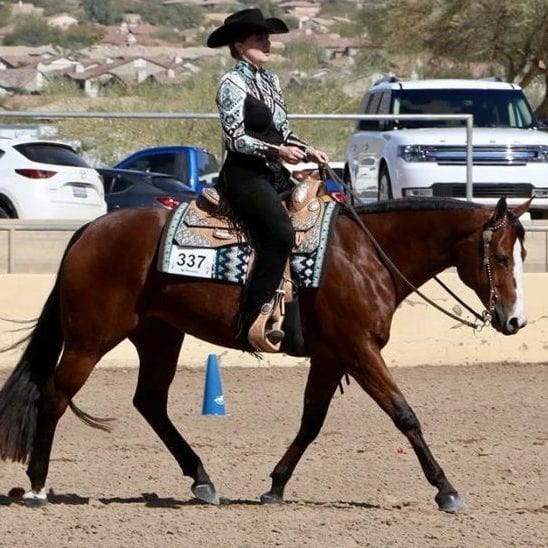In recent years, judges have been upping the ante at peak levels of competition by incorporating unique obstacles and maneuvers into pattern work. The horse showing community has been abuzz over unforeseen twists in all types of pattern classes. Remember the bushes and the old-school cross-overs in the Amateur Showmanship at the past two AQHA World Shows?
New challenges not only create an opportunity for growth and keep the competition fresh, but they also leave the door open for anyone to end up on top. That being said, when new challenges surprise us as exhibitors, we sometimes hit the panic button.
So how can exhibitors remain ready for anything?
Accomplished coach, Carla Wennberg, shares her advice on tackling any pattern with confidence. Among the many accolades of Carla’s career are 33 years as an AQHA judge and 13 years as a coach for the St. Andrews University Western Intercollegiate Horse Shows Association (IHSA) team, which competes in horsemanship and reining. During her time with St. Andrews University, Carla has coached the team to numerous successes, including back-to-back national championship titles in 2016 and 2017.
Establish Routine at Home
 Any exhibitor has probably heard that to show well; you have to put in the work at home. Carla believes in establishing a practice routine that is so consistent, it makes correct riding second-nature. When it comes to handling difficult patterns, exhibitors need to react instantly to their horse’s feel to maintain a picture of partnership. Carla points out, “If you have to think about it, you’re too late.” Therefore, she establishes confidence in repetition.
Any exhibitor has probably heard that to show well; you have to put in the work at home. Carla believes in establishing a practice routine that is so consistent, it makes correct riding second-nature. When it comes to handling difficult patterns, exhibitors need to react instantly to their horse’s feel to maintain a picture of partnership. Carla points out, “If you have to think about it, you’re too late.” Therefore, she establishes confidence in repetition.
Carla’s riders work patterns at every practice. After a warm-up, they run through them two to three times, break down maneuvers, review spots of strength and weakness, then put them together again. The team also practices balance-building exercises at every gait. Carla jokes that her team probably finds her approach boring at times, but repetition allows riders to develop their feel for guiding the horse.
Beyond building the physical skills for good horsemanship, a steady routine instills confidence that will carry riders through fierce competition. This principle applies to any pattern class. Whether that means perfecting your lope-overs, matching your trot strides to your horse’s, or nailing your set-ups every time, consistent, systematic practice establishes correct habits. Exhibitors who feel secure in their foundations can attack patterns with surety.
Fitness Foundations
Another important facet of a successful program is rider fitness. Two times per week, Carla’s team runs and stretches together. They also stretch in the saddle and drop their stirrups often. One exercise that she likes to use is riding without stirrups and with toes pointed down.
Though, of course, she notes, this is never desirable in the show pen, it helps establish proper contact of the rider’s leg with the horse’s ribcage while requiring the rider to keep centered seat bones. This exercise forces the core to lift the rider’s upper body and open the shoulders by isolating the torso from the legs. It challenges a rider’s balance, which is of utmost importance in expertly guiding a horse in any event.
Riders can use exercises like these to test and strengthen their riding foundations continually. This concept holds beyond horsemanship, though. A fit exhibitor can make trot work look like a breeze in showmanship, remain balanced through difficult trail sequences, and maintain that coveted, quiet lower leg in equitation. A solid exercise program establishes the fitness necessary to attack patterns with strength.
Mentality Matters
“You beat people mentally.” This is the cornerstone of Carla Wennberg’s coaching philosophy. Her approach to tackling any pattern is to do mental work. Upon arrival at the showgrounds, walk and talk about the pattern. Bring cones, enter the arena, and perform your pattern on foot as you would in your class.
Take note of various arena markers like banners, a staircase or a particular fencepost for spacing maneuvers. Gaits should be mimicked precisely, leads should be correct and arms should be held as they would be in the actual performance. For showmanship, be aware of your footwork, and consider which foot you’ll use to start and end each maneuver.
Most importantly, Carla says to voice your thought process as you move through the pattern, paying attention to detail in language. This forms the mental groundwork that will carry you through the pattern.
For example, if a pattern asks for an extension of gait or upward transition, Carla stresses verbally emphasizing “building” to the desired stride. This keyword primes the thought process to avoid mistakes like breaks of gait caused by attacking a transition too abruptly.
If you know that a particular maneuver will challenge you and your horse, be mindful of the way you talk through its execution. Set yourself up for success by describing the way you want it to go and precisely how you will guide your horse to perform that way. Then, when you enter the arena, your mind will know exactly what to do through every step of your pattern.
Confidence at Cone A
After you’ve done your homework and mentally planned your pattern, you need to stand out from a sea of talented exhibitors. When asked how judges pick winners from increasingly tight competition, Carla stresses confidence. She explains, “When an exhibitor walks up to the cone, I think yes, no or maybe.”
Those who earn a “yes” look eager to show their skills. They say, “watch this.” They move thoughtfully through their patterns. They know precisely what their next move will be, and communication to the horse translates clearly from gaze to body mechanics.
“Confident, mentally tuned-in exhibitors make the judges root for them,” says Carla. To achieve a winning impression, put together the steps above and know that you’ve done your due diligence to lay out a pride-worthy pattern. With plenty of at-home prep and a thorough mental process, you can approach any challenge with the confidence that judges want to see.
Stay tuned for the next segment of this two-part series, when we’ll learn what it takes to build a horse that is equally ready for anything.
About the Author: Natalie Linders is a senior in Animal Science and Agricultural Business Management at the University of Minnesota. She enjoys showing in all-around pleasure events and has a particular love for showmanship. Whenever possible, Natalie entertains herself by learning new things. Her ongoing goal is to compete successfully in as many different classes as possible with the same horse. She is thrilled that her new prospect shows promise towards this personal challenge, and she is eager to indulge her competitive streak in the show pen in 2019.









